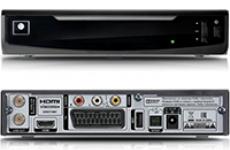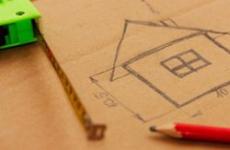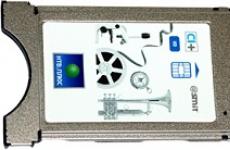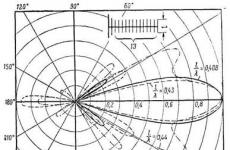Adjusting the satellite dish. Satellite dish: do-it-yourself installation and tuning of the antenna
Satellite dish at home or in the country has already become commonplace, like an iron or electric kettle. People are installing their own antenna for a good picture on the TV. The article and video will give you instructions for self-editing.
Kit assembly
In choosing a dish, the key is its diameter. For home reception in the southern regions, there will be enough antenna mirrors with a diameter of 0.6 m. In the northern regions, for a stable signal, the device diameter increases to 1.2 m. A large mirror provides a better signal, but it is more difficult for them to catch a satellite than a small one. A satellite dish only at first glance looks like a complex structure. You can assemble and install it yourself. Your dish set should consist of the following parts:
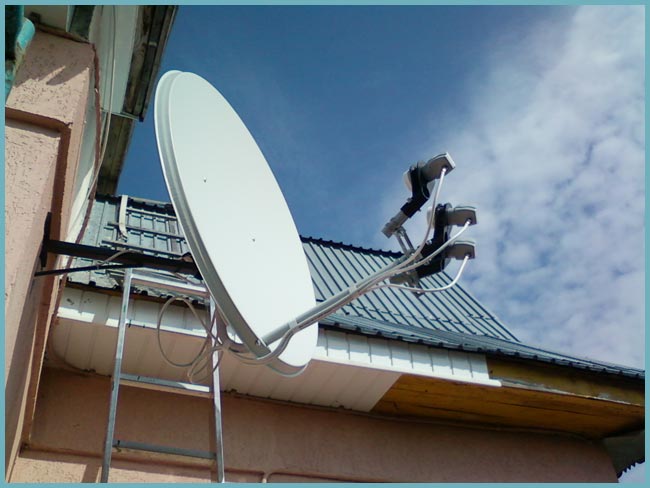
Attention! Rely on a consultant or seller when choosing a receiver, converter, etc. He will tell the model, focusing on your needs and price. The entire set can be purchased and bundled.
Antenna installation
First, determine the future location of the antenna. When planning, it is important to leave open space in the right directions, where the antenna will be rotated so that neither trees nor buildings block the signal path. Coordinate installation satellite equipment with any instances it is not necessary. If we are talking about a roof or a load-bearing wall of a multi-storey building, inform the balance holder of the house about your intentions. Otherwise, conflicts are possible in the future.
During the build process, you may need the following tool:
- hammer drill or drill with a set of drills;
- keys for 10 and 13;
- "Nippers";
- screwdriver;
It is better to assemble a plate with all the “stuffing” at home and only then fix it on the wall. The instruction most often lucidly explains what it commutes with, and the tools will help you. After that, you can proceed to installation.
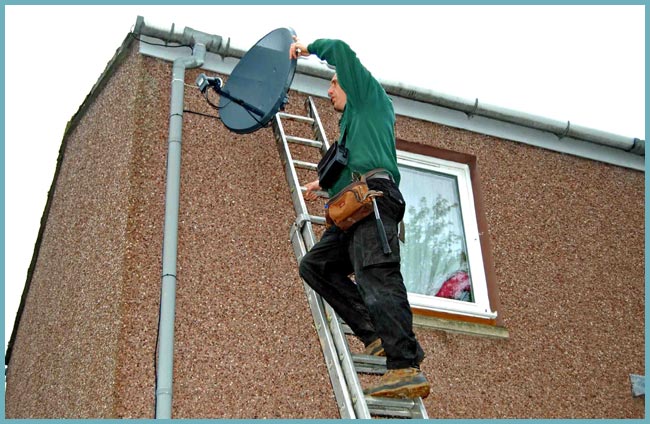
Antenna installation
The metal bracket on the wall should be fixed vertically and keep tightly. An anchor or a bolt is not important, the main thing is the safety and durability of the antenna. Otherwise, in windy weather the signal quality will decrease. After installation, you need to fine-tune the heads, properly connect them to the DiseqC switch so that the settings in the tuner match the connection in the antenna. Disek will last longer if you cover it with a trimmed plastic bottle.
Antenna tuning
To configure the antenna, it is necessary to calculate the azimuth of the satellites and the angle of elevation. An ordinary compass and formula will help you calculate them. In order not to fool their heads, the developers came up with a smartphone application program, for example, Satfinder. The azimuth calculator can be easily found on the Internet along with a map of the approximate coordinates of the satellites relative to your area. Also, the search engine will help you with the exact coordinates of your locality. All the water data you need to make in the formula, and the program will tell you about the azimuth and angle of inclination of your antenna.
Vertically standing offset plates already have an angle of curvature, its meaning can be found in the instructions. Fix the antenna firmly, but so that it can move with a slight effort, and point towards the satellite, taking into account the calculated data. A television is desirable for tuning the antenna. DiseqC with tuner (LNB IN input) is connected by cable. Most often, this can be done using the SCART connector, as well as the RCA output (“tulip”). Switching from DiseqC is only necessary with power off.
Council Manual tuning of the antenna with respect to satellites is a delicate matter. It is inconvenient to lift a TV to a height, so fit the gadgets: a phone, a car stereo or a tablet, which together with the tuner will give the picture already on the roof.
Once plugged into the network, the receiver should display a lack of signal. To set up, you need to enter the receiver's menu (as a rule, the code is 0000) and find the satellite you need. It is necessary to tune in to a strong satellite transponder: designate the frequency, polarization, indicate the symbol rate, fec. Strong is more often the one from which it is broadcasting several channels. If, after these manipulations, the signal scales twitched to high rates, then you calculated correctly. Now you only need to slightly adjust the signal by rotating the antenna, no more than 10 mm in azimuth and angle.

Special programs will help to adjust the antenna.
If the quality is poor, start the search manually. The sector for this is usually chosen in this way: by elevation +/- 10 °, in azimuth +/- 15 °. Rotate from the extreme corner, making a pause for 2-3 seconds. through 4-5 mm. After successful “catching” of all satellites, do not forget to isolate the connectors from external factors (for example, rubber) and carefully fix the cable on the way to the tuner.
How to install and configure a satellite dish: video
Satellite dish: photo
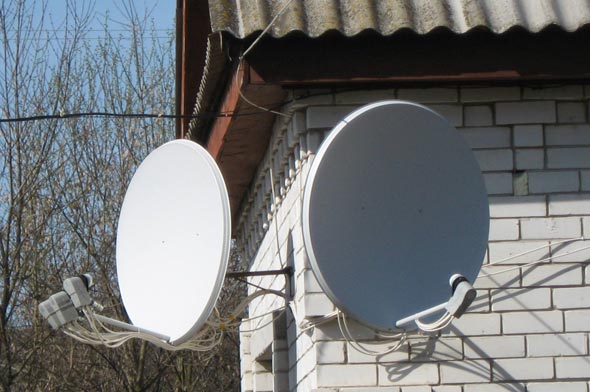
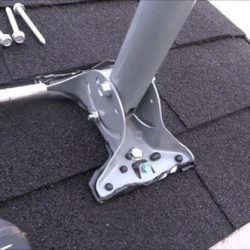
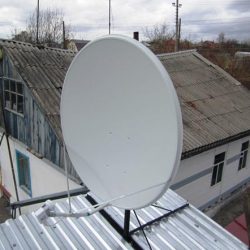
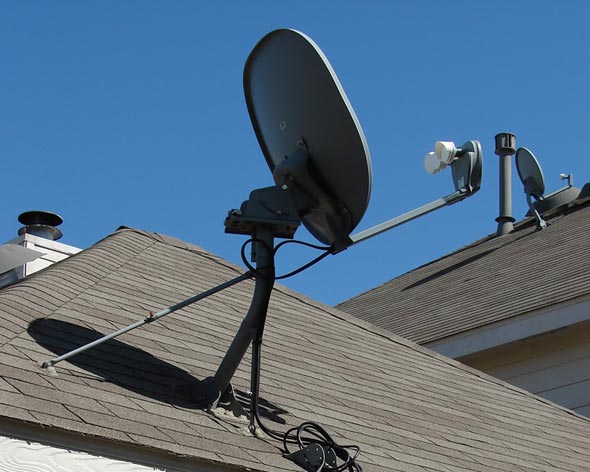
Despite the name, the article below will not tell you how to make a satellite dish yourself or to solder a receiver. Just a note about what you need to purchase and how to install and configure everything yourself to watch the TV channels on a plate.
Suppose you live in a country house, in a village, or simply "far from civilization." But you want to watch TV, and not a couple of channels that are broadcast on the air.
(A small digression: at the moment the etheric digital broadcasting. Find out if the number of channels you need is available in your area by means of terrestrial digital television? In this case, you will only need a prefix for receiving digital signal (if the TV does not support), and the antenna can not be changed.)
And so you decided to acquire satellite equipment to watch many TV shows. First you need to decide: what channels do you want to watch? If your goal is different Discovery, Viasat and / or purely sports channels, then we immediately inform you: it is better to conclude an agreement with one of the companies providing services satellite tv for a monthly fee. Such channels are transmitted in encrypted form and “on the ball” you will see only some of them. Fortunately, nowadays there are enough companies involved in installing satellite equipment and providing paid services. You can order the installation even in the wilderness itself, the only question is the cost.
If you decide to go this way, then we will give here some tips:
1) in the case of several proposals, carefully review the list of channels provided in a particular package, the need to pay extra for sports, educational channels, etc .;
2) the possibility of free installation of equipment by specialists of the company;
3) Is there a separate fee for "mileage to the client" when leaving?
4) not too much to pay attention to the reputation of the company: read on the Internet, ask around customers;
5) find out whether the reception is of high quality for the signal equipment installed by the company in your area;
6) it is often possible to connect profitably (for example, equipment or installation at penny prices, half of the subscription fee for some time to a more expensive package, or even a couple of months of “freebies”) for various kinds of shares; As a rule, to attract customers, large firms spend them regularly: on New Year, on the anniversary of the company, etc .;
7) well, and advice that is suitable for any transaction: read the signed contract carefully before signing, and not after, coming home and relaxing at your favorite TV channel; it may well be that the profitable, at first glance, action obliges you to use the services for at least a couple of years after the conclusion of the contract, otherwise they will write off the penalty, etc .; in general: be always on guard! and enjoy your viewing!
For the same who decided to do everything himself, material below.
Again, for a start, we will make a reservation: this information is most suitable for those who live in the European part of the former USSR.
So what is necessary?
To begin with: desire! The desire to do everything yourself (well, or with someone's help). Without this, you can not reach a successful final. Then patience, a firm hand, a minimum of tools and some cash. About the latter. Here a lot depends on where, what and from whom you will acquire. But even buying everything new, the equivalent of 100 UDS can be easily invested, if, of course, you do not chase brand equipment. Yes, and everything new to acquire does not always make sense, for example, if there is a profitable used offer on the market. The same plate or receiver is not a flash drive: it can work for a very long time and efficiently (although flash drives come across reliable :)).
And again a small digression: introduction to the world of satellite television. What is it all about? To get started, let's look at Wikipedia.
Geostationary orbit (GSO) is a circular orbit located above the Earth's equator (0 ° latitude), on which the artificial satellite orbits around the planet with an angular velocity equal to the angular velocity of the Earth's rotation around the axis. In the horizontal coordinate system, the direction to the satellite does not change either in azimuth or height above the horizon; the satellite “hangs” in the sky motionless.
Those. somewhere high in space, at an altitude of about 36 km from the surface of the Earth, an artificial satellite of the Earth rotates synchronously with it, which is a powerful transceiver television signal. It receives a signal from powerful (powerful) ground-based transmitting antennas and transmits it to a large area beneath. In fact, a lot of satellites. Each of them broadcasts to a certain territory according to the direction of its transmitting antennas. Several conclusions follow from this: the satellite is very far away, it is limited in mass, volume, power supply capabilities, it cannot be repaired in which case, hence the complexity, duplication of systems, etc. From all this, the conclusion: the power of the transmitting signal is limited, the signal from the satellite is very weak.
Then, the satellite is expensive, so it must be used to the maximum: transmit through it as many channels as possible to a large area of the Earth. The second conclusion: conventional technologies, which are still used for broadcasting television and radio broadcasting, are not suitable - too few channels are transmitted. Therefore, satellite television uses modern digital data transmission methods. The third conclusion: all channels in one satellite can not be "stuffed" for technical and organizational reasons.
Now let's see: what do these conclusions turn to us?
A weak signal reception technology is required. For this, a parabolic antenna is used. Here - the larger the area of a parabolic mirror - the better. Better for a signal that is collected and focused to a point. But the larger the antenna - so it is more expensive, harder. It is harder to mount, and securely fasten to counter a strong wrench - generally a problem at home, as a rule. Therefore, in practice, choose the size sufficient for high-quality reception, and this for most parts of Eastern Europe, the diameter of 0.8 meters. One of the most common diameters is 0.95 m.
There are two main types satellite dishes: direct focus and offset. The first in the focus of a parabolic mirror, which coincides with the geometrical one, have a receiver (feed) of the signal. In the second, the signal collected from a point from a parabolic mirror is reflected to a point below the geometric center of the antenna. This eliminates the shading of the useful area of the antenna by the irradiator and its supports, which increases its efficiency with the same area of the mirror with a direct focus antenna. In addition, the feed is installed below the center of gravity of the antenna, thereby increasing its stability under wind loads. The offset antenna mirror is mounted almost vertically. Depending on the geographical latitude, its angle of inclination varies slightly. This situation eliminates the collection of precipitations in the antenna bowl, which strongly affect the quality of reception. On the lumen of the antenna is not a circle but an ellipse, stretched vertically. The dimensions of the offset antenna usually lead to the equivalent of gain with respect to direct focus. If horizontally this size coincides, then vertically it will be approximately 10% larger.
In the future, under the satellite antenna, we will only mean offset, as the most common.

Direct focus antenna.
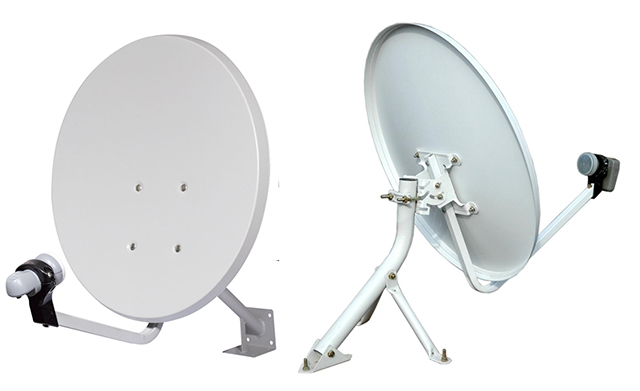
Offset antenna.
Also distinguish between fixed mounting antenna and movable. In the first case, the antenna is fixed to the base, in the second - to a special positioner. The task of the latter is to rotate the antenna in an arc for positioning on the desired satellite. The signal for turning gives, as a rule, satellite receiver. It takes some time to accurately position the satellite when selecting a program from a different satellite. Technically implemented using motor-actuator. Expensive, and, accordingly, not often meeting decision. In the practical part will not be considered.
As mentioned above, the signal from the antenna is focused at one point where the device called the converter is installed (LNB head or low-noise block converter or low-noise monoblock converter). Proceeding from the name "satellite converter", it immediately becomes clear that this device converts (converts) something. From the satellite, an electromagnetic signal is coming, which is focused by the satellite dish on the converter and converted by the LNB head to an intermediate frequency. This is necessary so that the signal can be efficiently transmitted further along the cable. In addition, the LNB head amplifies the received signal. Further, the signal via a coaxial cable from the LNB head goes to the satellite receiver, which, as a rule, is made by a separate device (the so-called satellite set-top box), but it can also be integrated into the TV.
Due to the fact that the satellite is very far from the receiving antenna, you have to send this very antenna very precisely to the satellite itself.
To summarize: to receive satellite television, it is necessary, in addition to the TV itself, to have the following equipment.
1) Parabolic antenna with a diameter of 0.8 m.
2) LNB head.
3) If there is a desire to watch TV programs from more than one satellite, then a switch (switch) of DiSEqC heads is necessary.
4) Coaxial cable.
5) Satellite receiver.
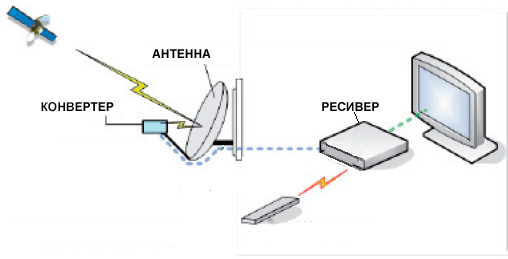
At the theoretical part ends. Let us turn to the practical.
First, determine the location for mounting the parabolic antenna. Height above ground does not play a special role. It is important that there are no obstacles on the satellite antenna line. Even the crown of a tree. For the inhabitants of Eastern Europe, the direction to the satellite will be southern, shifted to the west or east, depending on the coordinates of the antenna and the satellite. After all, we remember that geostationary satellites are being put into equatorial orbit.
The mounting location must be firm and secure: even the smallest oscillations of the antenna will lead to a loss of signal. The best option - the main wall of the building or reinforced roof of the roof. But other options will also work, for example, a rigidly hardened vertically installed iron pipe of such a diameter that it does not swing when the wind gusts. Depending on the chosen mounting option, select the appropriate fastener, which is fixed by one side to the fixed surface, the antenna itself is fixed to the other. As a rule, the antennas themselves are not equipped with such a detail. This may be an improvised product, the main thing to remember is that the antenna has a large sail area and will need to be sent to the satellite exactly, i.e. important is the reliability and ease of installation and configuration of the antenna itself.
Then choose, in fact, the antenna. It is better to ask the owners of satellite equipment in your area, what they use the diameter of the "plate" and whether the reception quality during heavy clouds and / or rain. If, for example, it turns out that when receiving a antenna with a diameter of 0.8 m there is a loss of signal during a heavy rain, then you should consider purchasing an antenna with a diameter of 0.95 m. At the same time, overpay for the “dish” 1.5 m in diameter does not make sense. In addition, it may turn out that the person who provided you with the above information simply doesn’t have an accurate enough direction to the satellite. In general, here will help tips knowledgeable and experience of neighbors with the "plates".
After, it is worth deciding from how many satellites do you want to watch TV shows? In theory, you can “acquire” antennas like mushrooms after rain, but in practice the most common option is one “plate”, mount for three receiving heads, three LNB heads, a DiSEqC switch for 4 heads, then a cable from DiSEqC to the receiver, the receiver itself, and from him to the TV. This is the so-called multifeed scheme. Look again at Wikipedia.
Multifeed is a set of devices (in particular, converters) designed to receive a signal from several satellites on a parabolic antenna. Multifeed is often called the bracket on which additional converters are mounted.
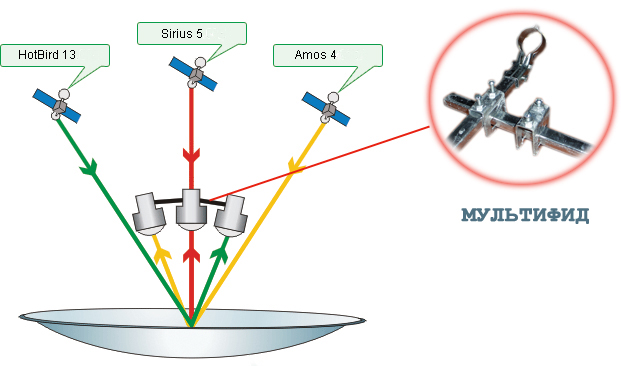
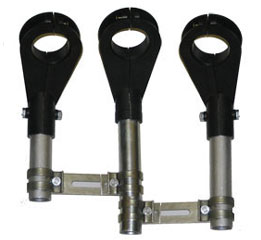
Such a scheme has been worked out over the years; it allows you to watch the maximum of Slavic-language programs with minimal cash investments. With three LNB heads, manually, without resorting to special equipment, it is possible to adjust the acceptable signal quality to the three most popular satellites in Eastern Europe: Amos 4W, Astra 4.9E, Hot Bird 13E.
Here the beauty is that for these satellites you can use one antenna. First, the antenna is configured with a central head, as a rule, on Hot Bird 13E, although it is possible to any other. This changes both the position of the plate itself and the head to achieve the maximum signal level. The signal from this satellite with the best quality setting will be the strongest. Then two others are configured, but only by means of the heads themselves.
The most common type of head LNB - on one way out, as the most popular and cheap. From it, the signal goes via cable to the DiSEqC switch or to the receiver. With this scheme it is possible to serve the signal only one TV. But there are heads for more leads, which allows one antenna and the LNB head to supply more than one receiver with the signal, saving on the equipment itself. This is very convenient if, for example, in the house more than one TV.
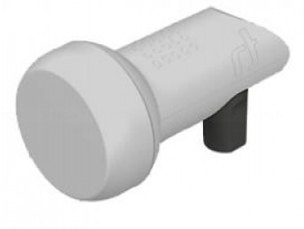
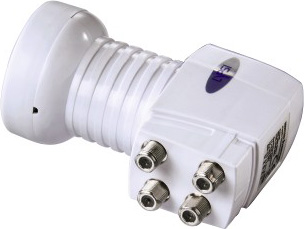
LNB heads: with one exit and four.
In the second case, all 4 outputs can be connected to different receivers or DiSEqC. The receiver can work with only one LNB head at a time, this is where the DiSEqC switch is needed if you want to watch several satellites on one “plate”. Depending on the program chosen by the user, he connects one or another LNB head to the receiver and supplies the supply voltage necessary for the head to work. In the overwhelming majority of cases, there is only one DiSEqC between the LNB head and the receiver, but there are intricate circuits with cascading DiSEqC, but these are rarely needed cases that we will not consider them.
Next, you need a coaxial cable to connect the DiSEqC and receiver. It must be taken with a margin of a couple of meters relative to the distance that you die out. But remember that the longer the cable, the greater the loss in it.
It's time to talk about the receiver. This is a very broad topic.
Most TV channel lovers will find the simplest receiver, for example Orton 4100C. But the general information on the choice of satellite set-top box does not hurt anyone.
First things first if you have modern tv, then look at his instructions or read on the Internet - it may happen that the necessary digital signal receiver is already built into this TV. If not, then here is what you should pay attention to.
1) The number and type of signal outputs, as a rule, must be at least three of them: ordinary antenna output, SCART, normal Video-out. In this case, it is easier to avoid a conflict when connected if there is other video equipment that is also connected to the TV, such as a DVD or BLUE-RAY drive, game console, radio digital television receiver, etc.
2) Does the receiver support HDTV (high definition television) signal? In our area, this is still a curiosity - the presence of clearly broadcasting (in the native language) HDTV channels, and even those that can be watched for free, but the time does not stand still.
3) Availability of instructions in plain language.
4) The number and type of service connectors. They are necessary for flashing the receiver. Re-flashing is necessary to correct the errors of the current firmware or to update the list of channels. (Yes, yes, the receiver is the same specialized computer as a telephone or router, and it also needs to “flood” something from time to time). Ideally, there should be two such connectors: RS-232 (pins in two rows) and USB. If there is no USB, then it is not a fact that your computer has RS-232 (it’s also a COM port), but if you wish, you can buy an RS-232-to-USB adapter. And still need so called null modem cable. If there is no RS-232 on the receiver, but only UBS, then it is not so scary, because any (well, almost) personal computer older than 1996 has at least one USB port.
5) As a consequence of the preceding paragraph, it is very desirable for the receiver to easily find the firmware, for example, the program code from the manufacturer, and the list of channels on a specialized website, or both in second place. There are a lot of options for popular models, but for exotics you will have to search. But you have to be careful, it is not so difficult to “bungle” the receiver.
6) If it is not possible to flash the receiver, then it should support the addition of satellites and channels, key input, in manual mode from the remote control. The case is tedious and requires care, but less likely to completely disable the equipment. Although ... in the right hands ...;)
7) If there is a desire to watch paid channels now or in the future, the receiver should support special security cards with keys. This means that there is a special connector and support for the firmware.


